#like 4 example the expectations set on me as a child was ABSURDLY high .
Text
idk if i rlly am unable to feel intense hate for something or i conditioned myself into thinking that hating soemthing makes me even more of a bad person so i refuse to feel such things HMMM
#cw rant#ʕ •ᴥ•ʔ idle chit chat#IDK❕i was always known as that one really caring and generous big sister#and whenever i express that i am upset i always get told 'why are you being like that?' and idk . perhaps ive been too nice to people#ALSO WHEn I RANT ABT STUFF LIKE THIS IM NOT LIKE . SAD ABT IT .#i just genuinely wonder hawuhhebfil#but yeah i think the emotional invalidation that i grew up with fucked me up like that LMAO#ngl i dont rlly even feel VERY strongly abt anything???#i know that my posts here on tumblr r very like yk energetic and BAM BAM but when it comes to irl i just . dont hklwhjr#gosh i am the exact opposite of my online self its so weird#thinking back on it though my childhood rlly shaped me into who i am today in maybe not so very good ways huhu#my childhood was pretty good though . it could be way way worse but there were very miniscule things that rlly impacted the way i behave😭#like 4 example the expectations set on me as a child was ABSURDLY high .#and everybody always praised me and stuff and i was so goddamn afraid of disappointing my family that i fainted on my desk while doing hw at#10 yrs old . yeah . JUST 10 YRS OLD#fainted due to overworking hawjgvhfk#also i was going to like . 2 schools at the time so like the stress was doubled hahahah darkest time of my life fr#ngl i like being my own therapist a lot and psychoanalyzing myself and my own thoughts🔎#its pretty interesting. the way i think ;0
2 notes
·
View notes
Text
Kobayashi’s Maid Dragon Episode 4 Notes

These yellow hats are tsuugakubou 通学帽, “commuting to school hats.” They are required by many elementary schools in Japan; students must wear them when traveling to and from school (which most children do by walking, at least part of the way; school buses aren't a thing) for various reasons. The most commonly cited is “to avoid traffic accidents” by making the children stand out, but others include preventing heatstroke, making them easier to spot for teachers, or differentiating which grade a student is in.
As the previous sentence implies, their design may change as you go up the grades (yellow for first graders, blue for older, as an example) or sometimes by gender. Depends on what the school wants to do with them.
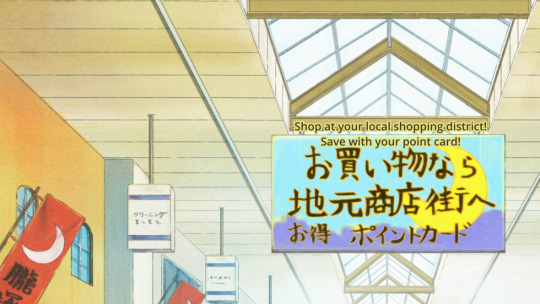
Point cards are an absurdly popular way of encouraging repeat business in Japan, with lots of small business using non-electronic ones (marked by just a custom stamp). If you’re not careful your wallet will be overflowing with them in no time.

The “zuuun” sound she makes here is, as you could probably guess, the sound effect for this sort of emotional gloom or a sense of heaviness (physical or not).
Japanese has a huge wealth of these “sound effect” words, and they’re a pretty normal part of conversation—especially for kids, but also adults and to an extent even in formal situations. You’re surely familiar with “onomatopoeia” (also known as a phonomime), a word that sound like a sound; “buzz” being a common example. You may be less familiar with the words phenomime and psychomime; words that “sound” like actions/conditions of the physical world (something going “round and round and round…”) and words that “sound” like emotions/feelings/mental states (a “pounding” headache).

You’ll notice she says "kawaii" the first time, and "cute" the second. English is a required subject in most Japanese schools starting in late elementary school, so while people may not be able to actually speak it, they do know a bunch of random vocab words. And it's reflected in Japanese media: you can just drop in English like this and expect your audience to understand it. It's kind of a neat strength of writing in Japanese (and some other languages) that’s hard to reproduce in English, as there’s no standard second language everyone has to study—and not as much acceptance of randomly speaking other languages in the middle of a sentence anyway (somewhat ironically, given how many loan words English actually has).

She uses the verb 仰る ossharu here, which is a very formal/respectful form of “to say,” like how you would refer to something your boss or a client says. The impression it leaves in this case, at least for me, is like how a parent will sometimes sort of jokingly speak “humbly” toward their kid, like they’re a princess or something.
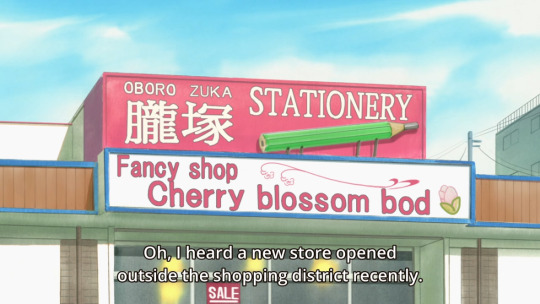
I think this is supposed to be “bud” not “bod,” but I’m not sure if it’s a mistake on Kyoani’s part or an intentional misspelling for realism, because that sort of mistake is a super common sight around Japan.
“Fancy” as a loan word in Japanese is not really associated with “expensive” the way it is in English, but is instead used to refer to cutesy decorative things. “Fancy Shop” is actually a word you can look up in (some) Japanese dictionaries, defined as “a store that specializes in selling ‘fancy’ ‘goods’.” (“Goods” being another common loan word, basically “merch” in English.) You can google image search “ファンシーショップ” (fanshii shoppu) and get a good feel for what it’s like.
Hello Kitty and that whole aesthetic is a decent example as well.
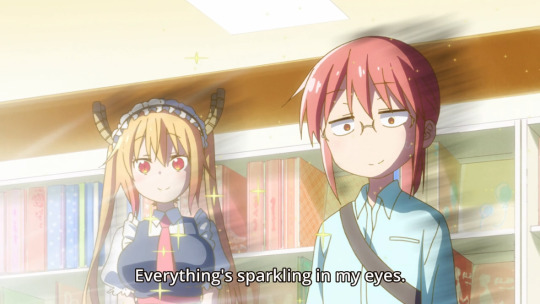
She uses another of those sound effect words here: chikachika. Basically the idea is a prickling sort of pain; it’s not just sparkling, it hurts to look at. It’s a relatively common gag line for an older person to say when looking at “sparklingly” youthful stuff, in that “I’m so old” sort of way.
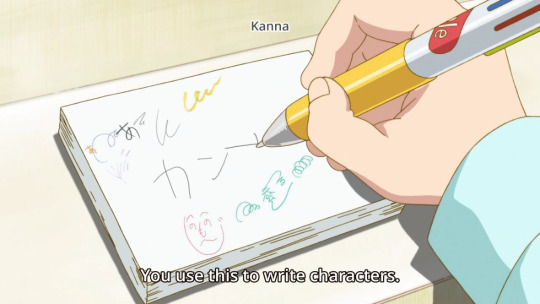
That little face there is the henohenomoheji face—so named because it’s made out of the hiragana he (へ) for the eyebrows/mouth, no (の) for the eyes, mo (も) for the nose, and ji (じ) for the face’s outline and one ear. It’s a popular little doodle and you’ll see it on stuff like scarecrows or background characters in manga (when the author wants to lampshade the fact that they’re meaningless background characters).
|へへ
|のの "
| も /
| へ /
カンナ is Kanna in katakana, the set of kana used primarily for foreign words/names; all of the dragons’ names are written using it. It’s another way “foreigners”* are different from Japanese in Japan, whose names are written in kanji. Well, generally, anyway; some people give their kids (mostly girls) hiragana or, even more rarely, katakana first names, and often very young kids will write their names in kana anyway due to not having learned kanji yet.
*Mostly excluding people from countries that also use Chinese characters to write names, like say China—though even then you can usually tell "oh this is a Chinese name" from the choice of characters.
It’s actually a pain sometimes, as some forms and computer systems are designed with Japanese names in mind, which basically means you’ll never need more than like 4 characters each for first and last name. If you've got a longer name, it often won’t fit in those cases.

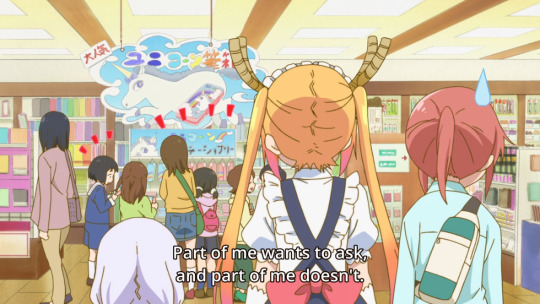
Did anybody miss this joke?

The sign, as you might expect, basically says “Sweets Erasers” and “Warning: Do Not Eat”.

The sign here is pointing out that these are those “safety buzzers” mentioned earlier...which you probably noticed.
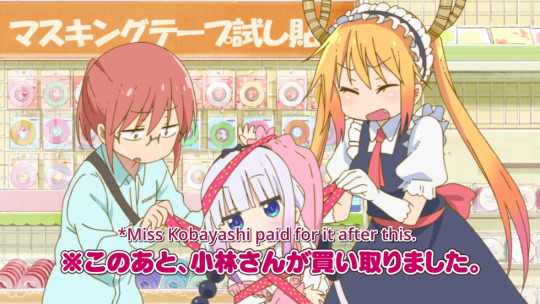
This is a play on a disclaimer(?) message that is/was common on certain Japanese TV shows: “この後スタッフが美味しく頂きました,” basically “the staff enjoyed eating it after this.” Japan suffered some pretty bad food shortages around the end of WW2 and, as cultures tend to do after experiencing that sort of thing, developed a strong norm against wasting food. Due to that, TV shows that wasted food on set felt the need to show that message, “after filming we ate this and were thankful about it; it wasn’t wasted,” to avoid blowback from angry viewers. It sort of occupies a similar spot in the culture that “no animals were harmed in the filming of this movie” does in the US. Both arise from a real effort to hold studios accountable, but are also often used as material for jokes.
The sign in the back specifies that this is masking tape, not ribbon, in case that’s what you thought it was.


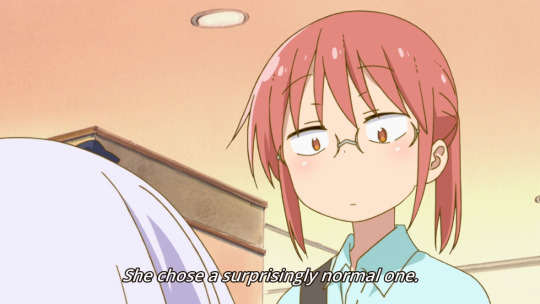

“Backpacks” here is actually a very specific type of backpack, mostly unique to Japan; ランドセル randoseru, originally an old loan word from Dutch: ransel. This type of backpack is exclusively used by elementary school students—and indeed a large majority of elementary school students use them, as has been the tradition for several decades. Like a lot of Japanese school traditions it originally started as a military thing that seeped into the mainstream while Japan was feeling particularly imperialistic.
As you can see, they tend to be stupidly expensive for a backpack. The cost is somewhat deserved at least, as they are mostly handmade from quality materials and will easily endure the whole six years of a child’s elementary schooling. The hard shell that keeps the boxy shape helps keep the kids from breaking or crushing crap they put in it too, so that’s nice I guess.
They tend to have a strong nostalgic value as well, and people will often hold onto them as keepsakes (i.e. stuffed away in an attic or closet to be looked at once every twenty years or so, probably).
In addition to the above (which would not get me to pay that much, personally), many schools have traditionally required, and continue to require, that students use one. Some even mandate the color, though that’s not quite as common as it used to be and nowadays you can get them in a bunch of different colors instead of the traditional black or red*. Even in places where it’s not required, it’s not unheard of for people to use them anyway, again due to tradition and not wanting their kid to be the only one without (which would probably lead to both teasing of the kid by their classmates, and gossip about their parents by other parents).
*Red being a traditional color helps explain why Kobayashi reacted as she did there. In particular, black=boys & red=girls used to be a thing too.
It’s possible to get them for significantly cheaper in places (like online retailers), though those will generally be of lower quality (or at least less fancy materials; you’re probs not gonna find a leather one for 7,000 yen). Fancy designer ones can of course go for absurdly high prices, though that’s true of any product nowadays.
By the way, as you can see here, nigh on everybody carries a bag of some sort in Japan. Since you’re not likely to be using a car, it’s not like you’ve got anywhere else to put stuff you might need to have with you when out and about.

Japan is still largely cash-based when it comes to individual purchases, a fact which provides a little context to this bit. Outside of large chains, many places won’t take cards, and until fairly recently debit cards basically weren’t even a thing—they still haven’t really caught on, but at least you can get one from some of the large banks now.

School uniforms and certain other supplies are largely purchased through small local stores like this; if you’ve lived near a school you’re likely to have seen one. As Kobayashi’s line implied, they often have deals with a school so that you have to buy through them. It reminds me of how you have to buy gowns/hats/etc. for US school graduation ceremonies through a certain vendor the school (district?) has a deal with.

As you’re probably aware, this is a common and powerful sentiment in Japan, especially the more traditional areas. There have been cases of schools forcing children to dye their hair black even if it was naturally another color, which is clearly an example of taking it too far. On the other hand, there is an argument to made for fostering a sense of equality with your peers by having the whole class in the same uniform, with the same shoes, carrying the same bag, etc., so it’s not like it’s purely hard-headed attachment to tradition and conformity. I guess.
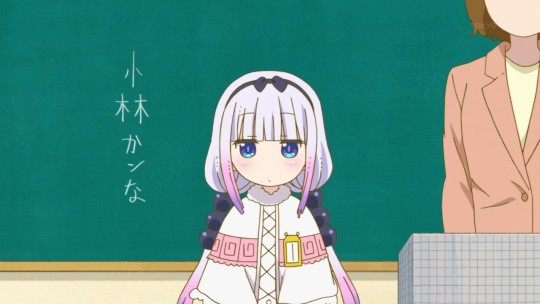
Kanna writes the na in her name with hiragana by mistake (な instead of ナ). ...Or so you’d think, but she was doing a good job writing kanji earlier, so I’m not sure if it’s an honest mistake or a calculated one to appear less infallible. Especially considering the fake tears we see later.
Edit: As has been pointed out, the Ka is also wrong in the same way: か instead of カ. Not gonna lie, I sometimes make that mistake myself when writing them out by hand, since the primary difference is just whether there’s that corner dash and it’s easy to add it out of muscle memory—hiragana is a lot more common to write than katakana.

As mentioned before, handwriting is seen as very important in Japan—in particular, the specific method of how you’re supposed to write any one character (including letters/numbers). I bring this up again here because Kanna totally writes the 9 the “wrong” way.

Cram schools (塾 juku) are private “after-school-schools” that parents put their kids into to improve their chances of doing well on the all-important school entrance exams. They’re often seen as a pretty shitty experience for the kid (who wants to go to school twice in one day? or on days off?), but a necessary evil in order to make sure they can get into a good middle school, to get into a good high school, to get into a good college, to get a good job, to have a good life.

These rags, blue/pink clips, and rack are a common sight in many places in Japan; typically schools and offices where the students/employees do a basic cleaning of the classroom/office.
As you may have noticed in other anime set in schools, students tend to do a lot of the work of keeping the school clean. Part of that is (probably) to save on cleaning costs, but it’s also intended to foster a sense of community among the students and get them feeling invested in the school, as well as teach responsibility.
In many workplaces this tradition continues, to a greater or lesser extent. A white-collar worker might not be cleaning the office bathroom, but they will likely have a weekly (or biweekly, whatever) cleaning event where everybody gets a rag and cleans up any dust, coffee/tea rings, etc. around their desk for a few minutes, maybe do a little vacuuming. It’s as much a team-building exercise as it is a cost-saving technique (in theory).
Of course, it also helps establish that it’s now at the end of the school day.

This is that phrase the dude in episode two was repeating: maji yabakune マジやばくね. The maji is just an emphasis thing, very similar to “really” in English (both like “that’s really weird” or “wow, really?”). “Seriously” works too, especially considering that maji is short for majime 真面目, which is a less slangy word that basically means serious (it’s more than just that but whatever). Depending on use, it may be closer to “rly” or “srsly” instead (interneeeet).
The second word is yabai (or more specifically the negated version of it*, yabakunai, or even more specifically the slangy/slurred way of saying that, yabakune). Yabai is a slang word that’s exploded in popularity over the last several years (though it’s roots are much older). It used to mostly describe a situation that is/had gone bad, similar to something like “oh shit.” Much like “shit” though, it’s become almost a catch-all word you can use to refer to basically anything. “This is shit.” “This is the shit.” “This is my shit.” Another example you’ll hear is using it to refer to people, like “that guy’s yabai,” which can mean anything from “don’t fall in with that dude he dangerous” to “that guy’s nuts” to “damn look at that dude go, fuckin beast mode.”
It’s not quite as vulgar though, so it’s not necessarily a bad word for kids to say.
*An extremely common grammar construction in Japanese is negating something and sticking a question mark after it to make a phrase similar to “Is that not ___?” in English. That’s what’s going on with “yabakune.”
So here, it’s Kanna processing the conflicting statements Saikawa made and being like a combination of “she nuts” and “danger Kanna Kamui, danger” (in a silly sort of way).

The line here technically isn’t want to be friends (友達になりたい tomodachi ni naritai or similar), but want to get along well (仲良くしたい nakayokushitai). It’s a pretty insignificant difference, but it makes slightly more sense in context for her to be saying it that way (at least in the Japanese, where both sound natural).


“Blundering” here is bukiyou 不器用, which is a common adjective for someone who’s clumsy (especially in a “bad with their hands” kind of way) or bad at expressing their emotions. If you’re familiar with the stereotypical gruff Japanese dad who can’t make himself tell his kids he loves them (unless maybe at end of an emotional story arc) archetype, this is the word typically used to describe them.
So basically the nuance here is that they’re all “you should have just said you wanted to be friends with her from the start, why’d you have to be all combative?” Which is probably something they think about her a lot.

For the curious, the words here are kurasu 暮らす and ikiru 生きる. The former is a verb for the act of “living” in a “what you do in your day to day life to get by” type of way; what house you live in, what food you eat, your routine, etc. The latter is “living” in a more philosophical sort of way, like “how you choose to live your life.” Or biologically I guess, like being alive versus being dead.


The way she words this, to me, implies less “for now, I can” and more “now, I can.” Like she couldn’t understand it before, but now she can.
Maybe a better way to put it is that the translation here seems to deal with the “now" and the “future” (she agrees now, but may not in the future) whereas the Japanese phrase used (ima de wa 今では) deals more with the “past” and the “now” (she didn't agree with it, but now she does).
Also for what it’s worth, in the manga there’s one extra line after that: “Kobayashi-san is just that... [trails off]”
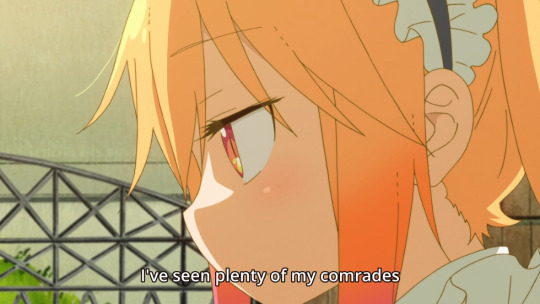

Also going back a bit, this line. The phrase "骨をうずめる hone wo uzumeru" doesn’t really mean to destroy oneself. Literally, it means to bury one’s bones, and idiomatically, it means to “devote yourself wholly to something.” It is (or maybe was, when lifetime employment was still big) commonly used like “I will bury my bones at this company,” meaning you were devoted to your work at that employer (and had no plans to consider leaving for another job in the future).
So the idea here is that she had seen many of her fellow dragons who started with just “I’ll just spend time/get along with this non-dragon” and ended up becoming completely devoted to them instead (romantically or otherwise), but had never been able to accept/understand that feeling/decision—until now.
Also worth noting the "共に tomo ni" (together with) that she used with the bone-burying phrase—the same word she used twice earlier when talking about living with humans (tomo ni kurasu and, tomo ni ikiru).
So depending on how you want to interpret it, idiomatically or literally, the dragons she knew got "too" involved with a non-dragon and then either just became super emotionally attached, or died together with them.

This line is actually "いつの不良だ? itsu no furyou da?". Furyou is one of the words you’ll see as "delinquent" a lot, and itsu is "when." Basically the way they’re acting makes them seem like stereotypical delinquents from year 19XX, and she’s sort of reacting to both how out of date it is, plus the "delinquent" thing itself. If you were writing a similar scene from scratch in English, you might go with a “____ called, it wants its ____ back” style joke.

She’s saying “moe” here, in case you didn’t catch that. That sort of “moeeeee” squeal is pretty stereotypical (if sort of out of date) as a thing Japanese anime otaku would say when looking at something cute. When I say stereotypical, I mean that was kind of the perception even relatively normal people had about what otaku did, “oh those people who go like ‘moeeeee’ at anime, right?”


Get it he’s fat (American) and big (gorilla). Gorilla is a pretty standard jokey way to make fun of someone big and stocky. You’ve probably heard it used in several other anime/manga before (often PE teachers or judo club members, especially with square jaws like that).

The phrase here is kubi wo aratte mattero yo 首を洗ってまってろよ, the ever-popular “wash your neck and wait.” It refers to an old line from back in the samurai days, when it was a thing to wash your neck prior to committing seppuku—after you gut yourself, someone else is supposed to cut your head off, and it would be just dreadful for someone to have to cut a dirty neck, heavens me. Basically the idea is “yer fuckin dead mate.”
This is an example of a sutezerifu 捨て台詞, basically a parting line made by an aggrieved party, like “I’ll get you for this!” or whatever. In fiction it’s heavily associated with the bad guys. If you think of Team Rocket they’re a perfect example.

The phrase for picking a fight in Japanese is “selling a fight” (and “fighting words” can be “selling words (urikotoba 売り言葉)”, as here). Then if someone takes you up on it, they “bought” the fight.

Specifically she has no jinbou 人望, which is basically popularity, but in a “people would go out of their way to help you” sort of way; it’s not the same word you’d use to refer to a popular movie, for instance, or someone who’s “popular” but doesn’t have many friends (that would be ninki 人気).

“Explosive” here is actually the kanji for explode/explosion and heart, so it’s more like “Exploding Heart/Spirit.” It’s actually also the word for ground zero/the center of an explosion, though usually it has another kanji added to the end when used like that (爆心地 bakushinchi).
The ability to just toss whatever kanji together like this to create words that don’t necessarily have an actual meaning, but invoke a sort of emotional response, means you see this thing in titles and taglines and fiction (think attack names) a lot.
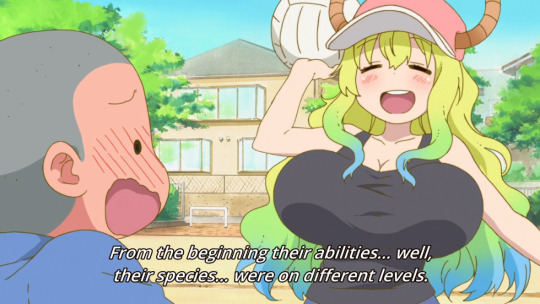
The phrase used to say “on a different level” here is ものが違う mono ga chigau. Chigau is different, and mono can mean many things, including “things,” and also including a euphemism for boobs.

She uses juurin 蹂躙 here, a fancy word for basically trample. It’s not a super common word, but it’s often used when talking about things like “trampled human rights” in news stories.

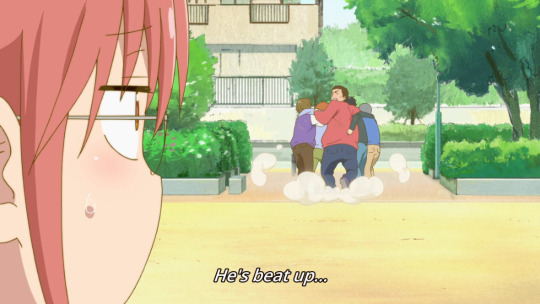
Another sutezerifu, and a particularly stereotypical one. Kobayashi doesn’t say “he’s beat up,” she comments on how absurdly stereotypical he sounds (こってこてだな).

Lucoa uses the first person pronoun “boku,” which is typically used by boys/men. Japanese has a bunch of words for “I/me,” and most of them are gendered to some extent or another; some common ones are ore 俺 and boku 僕 for men, atashi あたし and watashi 私 for women—though watashi (or watakushi) is used by everyone in formal/business environments.
Interestingly, the Japanese language is very gendered based on the speaker, but not so gendered based on the subject. So like in English it can be hard to tell someone’s gender online sometimes, but at the same time it’s useful information to know for pronoun purposes. In Japanese it’s easy to tell someone’s gender online (unless they specifically write to hide it), but at the same time you don’t even really need to know, for pronoun purposes anyway.
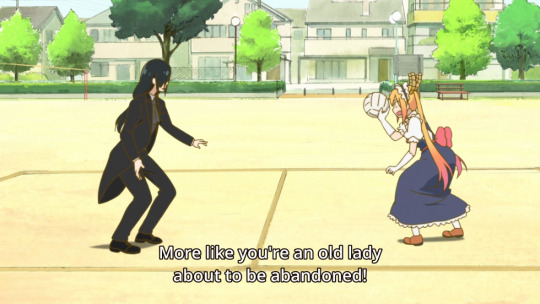
The phrase here is 姥捨て ubasute, an ancient (and possibly mostly mythical?) practice of abandoning elderly people (particularly but not exclusively women) in the mountains or elsewhere in the wilderness to die in times when food was scarce and the extra mouth couldn’t be fed.

You have to remove your normal shoes and change into indoor shoes (like slip-ons), when entering schools in Japan. In middle/high school you’ll typically have a shoe locker to keep those in, but in elementary school you often are required to have a bag to keep them in; hence the “slipper case” here.
Basically the same is true of physical education/gym clothes, hence the “gym clothes case.” The “gym cap” is basically the same deal as the commuting hat, but worn during gym/PE class. They’re often red and white (also reversible), and so sometimes referred to as kouhakubou 紅白帽 (red/white hats; “kouhaku” is a common word, as the red/white color pair has a lot of cultural significance, especially in relation to Shinto).

Bathrooms in Japan don’t have paper towels, so a handkerchief is an important item to carry when leaving the house.

The “pencil board” (下敷き shitajiki) is a thin plastic board placed under paper to provide a better writing surface (such as when writing in a notebook, which would otherwise have more “give” to it). Possibly due to the relatively intricate nature of kanji (look at this shit: 憂鬱), clean handwriting gets a lot of focus in Japanese primary education—calligraphy lessons, with brush and ink and all, are a regular feature of class—which I guess is where the mandatory status of these boards comes from.

The safety buzzer (“crime prevention buzzer”) is a common piece of equipment for kids to carry, so they can ring in case of kidnapping or similar crime; basically the “I need an adult” alarm. Since kids are generally walking to school unattended and there have been a few high profile criminal cases related to that, it makes sense schools would want to make sure these are something students are carrying.
Link to Episode One Notes
Link to Episode Two Notes
Link to Episode Three Notes
Link to Character Intro Pages
135 notes
·
View notes